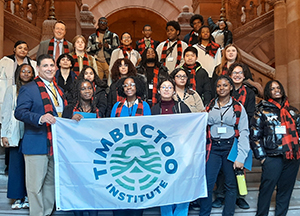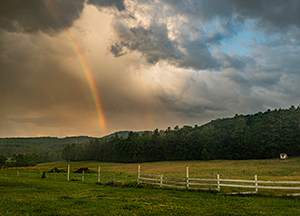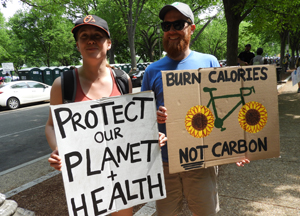
Forest Preserve and Private Land
Forest Preserve
The Forest Preserve is the state-owned land within the Adirondack Park. These lands are protected by Article XIV of the New York State Constitution, which states, "The lands of the state, now owned or hereafter acquired, constituting the forest preserve as now fixed by law, shall be forever kept as wild forest lands. They shall not be leased, sold or exchanged, or be taken by any corporation, public or private, nor shall the timber thereon be sold, removed or destroyed." The only way that this can be changed is through a constitutional amendment process.
Because the Forest Preserve contains most of New York’s most rare and sensitive forests, waters and wildlife, the state created the Adirondack Park State Land Master Plan (APSLMP), to guide its management. These lands are broken down into categories based on their capacity to withstand use. These categories are:
Wilderness
A Wilderness Area is an area where the earth and its community of life are untrammeled by man - where man himself is a visitor who does not remain. It is an area of state land or water having a primeval character, without significant improvement or protected and managed so as to preserve, enhance and restore, where necessary, its natural conditions, and which:
- Generally appears to have been affected primarily by the forces of nature, with the imprint of man's work substantially unnoticeable.
- Has outstanding opportunities for solitude or a primitive and unconfined type of recreation.
- Has at least ten thousand acres of contiguous land and water or is of sufficient size and character as to make practicable its preservation and use in an unimpaired condition.
- May also contain ecological, geological or other features of scientific, educational, scenic or historical value.
Wild Forest
A Wild Forest Area is one in which the resources permit a somewhat higher degree of human use than in wilderness, primitive or canoe areas, while retaining an essentially wild character. It is an area that frequently lacks the sense of remoteness of wilderness, primitive or canoe areas, and that permits a wide variety of outdoor recreation.
Canoe
A Canoe Area is one where the watercourses or the number and proximity of lakes and ponds make possible a remote and unconfined type of water-oriented recreation in an essentially Wilderness setting. The terrain associated with parcels meeting the above definition is generally ideally suited to ski touring and snowshoeing in the winter months.
Primitive
A Primitive Area of land or water that is either:
- Essentially Wilderness in character, but
a. contains structures, improvements, or uses that are inconsistent with Wilderness, as defined, and whose removal, though a long-term objective, cannot be provided for by a fixed deadline; and/or
b. contains, or is contiguous to, private lands that are of a size and influence to prevent Wilderness designation; or, - Of a size and character not meeting Wilderness standards but where the fragility of the resource or other factors require wilderness management.
Intensive Use
An Intensive Use Area is one in which the state provides facilities for intensive forms of outdoor recreation by the public, such as campgrounds and day-use areas. These areas provide overnight accommodations or day-use facilities for a significant number of visitors to the Park and often function as a base for use of Wild Forest, Wilderness, Primitive, and Canoe areas.
Wild, Scenic and Recreational Rivers
A Wild River is a river or section of river that is free of diversions and impoundments, inaccessible to the general public except by water, foot, or horse trail, and with a river area primitive in nature and free of any man-made development except footbridges.
A Scenic River is a river or section of river that is free of diversions or impoundments except for log jams, with limited road access and with a river area largely primitive and undeveloped, or that is partially or predominantly used for agriculture, forest management, and other dispersed human activities that do not substantially interfere with public use and enjoyment of the river and its shore.
A Recreational River is a river or section of river that is readily accessible by road or railroad that may have development in the river area that may have undergone some diversion or impoundment in the past.
Travel Corridors
A Travel Corridor is that strip of land constituting the roadbed and right-of-way for state and interstate highways in the Adirondack Park, the Remsen to Lake Placid railroad right of way, and those state lands immediately adjacent to and visible from these facilities.
Historic
Historic Areas are locations of buildings, structures, or sites owned by the state (other than the Adirondack Forest Preserve itself) that are significant in the history, architecture, archaeology or culture of the Adirondack Park, the state or the nation; that fall into one of the following categories:
- State historic sites.
- Properties listed on the National Register of Historic Places.
- Properties recommended for nomination by the Committee on Registers of the New York State Board for Historic Preservation and that are of a scale, character, and location appropriate for designation as a historic area under this master plan, and the state has committed resources to manage such areas primarily for historic objectives.
State Administrative
State Administrative areas are where the state provides facilities for a variety of specific state purposes that are not primarily designed to accommodate visitors to the Park.
This category includes the administrative offices of the Department of Environmental Conservation (DEC), Division of State Police and Adirondack Park Agency, as well as the DEC fish hatcheries, Department of Transportation offices and maintenance and storage sites, the Atmospheric Science and Research Center at Whiteface Mountain, the Sunmount Developmental Center, the Adirondack Correctional Facility, the Dannemora Correctional Facility, Lyon Mountain Correctional Facility, Camp Gabriels, and several sewage treatment plants operated by the Environmental Facilities Corporation. All of these facilities are in close proximity to public highways and are generally in developed areas of the Park.
Information on these land classifications came from the NYS Department of Environmental Conservation's website.
Private Land
The 3.4 million acres of privately owned land in the Adirondack Park is classified under the Adirondack Park Land Use and Development Plan in the Adirondack Park Agency Act. This plan is designed to preserve the natural resources and open-space character of the Park while providing ample opportunity for appropriate development.
Under this plan, the Park’s private lands are designated as follows:
Hamlet
Hamlets are the growth and service centers of the Park. These areas total 54,770 acres or two percent of the private lands. There are no building density requirements in hamlet areas.
Moderate-Intensity Use Areas
These areas total 103,567 acres, or three percent of the private lands. The density requirement for these areas is 1 building per 1.3 acres.
Low-Intensity Use Areas
These areas total 277,286 acres or nine percent of private lands. The density requirement for these areas is 1 building per 3.2 acres.
Rural Use Areas
These areas total 1,028,951 acres, or 33 percent of private lands. The density requirement for these areas is 1 building per 8.5 acres.
Resource Management Areas
These areas total 1,633,668 acres, or 53 percent of private lands. Special care is given to protecting the natural character of these lands. The density requirement for these areas is 1 building per 43 acres.
For more information on these land classifications, visit the Adirondack Park Agency's website.




